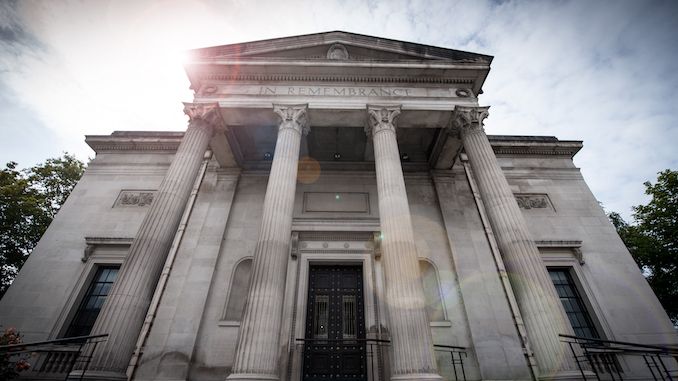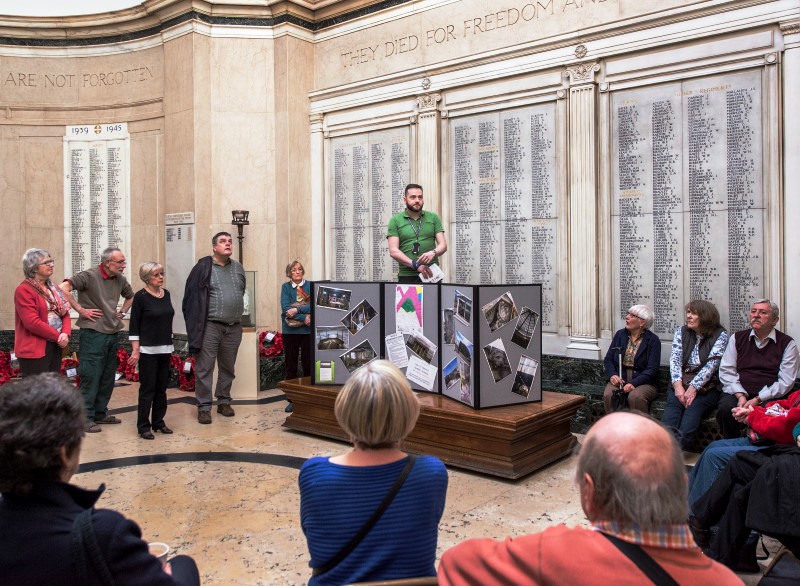
How long have you lived in Stockport?
What is that building opposite the Town Hall?
Have you ever visited it?
The chances are that you h ave never been to the Stockport War Memorial and Art Gallery. If you haven’t, you should be ashamed of yourself as it is a gem; unique, not just in England but in the world. It is the only building, anywhere, designed and purpose-built as a combined war memorial and art gallery. There are now forty people from Marple History who can look their friends in the eye; they have been and they have learned a lot. Lynda Jenkins organised one of the most moving tours the society has sponsored.
ave never been to the Stockport War Memorial and Art Gallery. If you haven’t, you should be ashamed of yourself as it is a gem; unique, not just in England but in the world. It is the only building, anywhere, designed and purpose-built as a combined war memorial and art gallery. There are now forty people from Marple History who can look their friends in the eye; they have been and they have learned a lot. Lynda Jenkins organised one of the most moving tours the society has sponsored.
At the end of the First World War, the “War to end all wars,” every community in Britain wanted to mark the sacrifice made by their own people. The initial idea was to erect a memorial to the soldiers killed from the parish of St Mary but the project grew rapidly until it involved the whole borough. Local companies became involved and a site on the corner of Greek Street and Wellington Road was donated by the trustees of the estate of Samuel Kay. This was an excellent site, the location of Stockport Grammar School until it moved to Mile End in Davenport in 1915. The main condition that the trustees imposed was that the building should house an art gallery, rooms for technical and higher education, and space for exhibitions of science, art and technology. It was also to provide a site, if required, for the extension of either the Municipal Technical School or Secondary School. The trustee's conditions meant that a substantial building had to be planned.
This coincided with the aims of committee to provide new public buildings as well as a monument to the dead. A number of eminent sculptors were invited to submit designs for the memorial and the design by Gilbert Ledward was judged "head and shoulders above anything else shown to them.” Ledward was regarded as representing the sculptural establishment, less conventional than Eric Gill but not as radical as Jagger. His sculpted group was a life size statue of Britannia, draped with a flag, standing behind a kneeling man representing the fallen. In her right hand she holds the Sword of Honour, in her left the Palm of Victory laurel wreath. A serpent lies crushed beneath the shield at the man's feet.
The architect appointed to design the building was a Manchester architect, J. Theo Halliday who was also responsible for Battersea Power Station. Ledward worked closely with him and the end result was well received by all. Ledward reserved particular praise for the architect's work in the Hall of Memory where the lighting via the stained glass dome, and the use of different coloured marble for the floor and walls made it "the most beautiful and dignified memorial I have seen.” As for the mayor. Charles Royle, he believed that the memorial was second to none "and which would occupy a place that would not only distinguish itself but the town to which it belonged." The foundation stone was laid on 15 September 1923 by the Mayor. Just over two years later it was unveiled by Prince Henry (YouTube Link), the third son of George V, later to become Duke of Gloucester.

The main building foyer leads through to the memorial hall, a semi-circular space with the sculpted group in the centre and name tablets on the surrounding walls. As well as the 2200 names from the First World War there are a further 1560 from the Second World War. Since then Stockport has continued the tradition and added names from subsequent engagements and, after 1974 when the Metropolitan Borough was created, names from the newly incorporated outlying urban districts including Marple. Indeed the latest name to be added to the Roll of Honour was Cpl Danny Winter RM of Marple, killed in Afghanistan.
To either side of the memorial hall are compact gallery spaces whilst upstairs there is a larger gallery extending the full-length of the building. The displays are changed frequently, up to fourteen times a year, and we were fortunate enough to see one of the exhibitions put on by the Manchester Academy of Fine Arts. The current President,  Gerry Halpin,(right) gave us an introduction to the work of the Academy, established in 1859, and followed this with a guided tour of the exhibition. A very suitable and satisfying follow-up to the emotional experience of the memorial hall. Everyone who took part in the visit came away enriched and fulfilled, not just spiritually but also physically. It is not often that we get offered refreshments both before and after a visit. Katherine, Susan and Nick could not have done more to make the visit so enjoyable and Phil’s introduction to the building and the memorial struck just the right note - comprehensive but informal.
Gerry Halpin,(right) gave us an introduction to the work of the Academy, established in 1859, and followed this with a guided tour of the exhibition. A very suitable and satisfying follow-up to the emotional experience of the memorial hall. Everyone who took part in the visit came away enriched and fulfilled, not just spiritually but also physically. It is not often that we get offered refreshments both before and after a visit. Katherine, Susan and Nick could not have done more to make the visit so enjoyable and Phil’s introduction to the building and the memorial struck just the right note - comprehensive but informal.
The popularity of the visit was demonstrated by the number of members who could not be included and it was a tribute to Lynda that so many people commented that the memory would stay with them for a long time. For those that could not go there is still every opportunity. Although closed on Mondays it is open all other weekdays from 1 p.m. to 5 p.m. and at weekends from 11 to 5. It is well worth a visit. Better still, make sure you book early for future visits put on by the society.
Neil Mulineux, ©
March 2017
Photos: Bill Beard, David Burridge & Arthur Procter ©
Below Gallery: YouTube video, Prince Henry unveils Stockport's the War Memorial in 1925





















